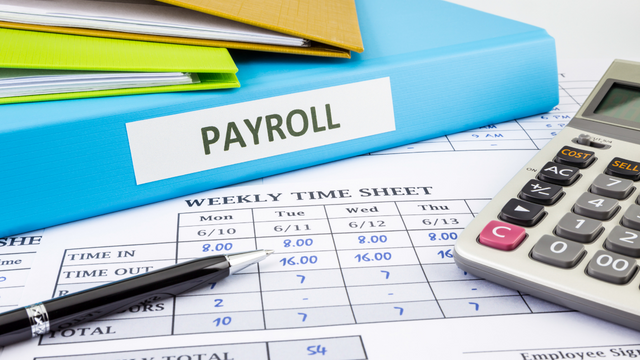Managing the day-to-day business operations is a little different when you’re self-employed, to say the least. Payroll can be one of the more time-consuming tasks as you must calculate wages and taxes.
Whether you’re a sole proprietor or hire contractors and W-2 employees, you can follow these steps to run payroll yourself.
In This Article
What Does it Mean to Be Self-Employed?

Being self-employed means you don’t work for an employer and own your own business. Depending on your business industry, you may work consistently for the same clients or only complete one-time projects for customers.
It can be a full-time income or a part-time side hustle that you can eventually replace your day job. You may also hire contractors or employees if you have the budget and need.
As a result, you have more liberty with how you work. However, there are more administrative responsibilities as you handle payroll, human resources and other tasks that don’t fit into your job description when you pitch clients or talk with guests at a dinner party.
While every freelancer makes money differently, you draw a salary and will pay self-employment taxes and file additional income tax forms. Since you’re self-employed, your taxable income reports on a Form 1099 instead of a W-2.
Self-Employed Business Structure
How you structure your business can determine some of the payroll processes. An accountant can help you choose the best structure for paying yourself a salary, self-employment taxes and how to pay contractors and employees.
Your business structure will be one of the following:
The tax treatment can differ for each filing status with S-Corp and C-Corp businesses being taxed as corporations. Therefore, the payroll rules can be more formal for these entities.
Sole Proprietor vs. Independent Contractor
If you’re a one-person business that hasn’t formed an LLC or corporation yet, you will file a Schedule C with your federal Form 1040 to report your business income and expenses.
As you sign up for freelancer business tools, you may need to distinguish if you’re a sole proprietor or an independent contractor. The tax treatment is similar but how you receive payments from clients can differ:
- Sole Proprietor: You typically invoice clients and can receive payment from various platforms, including direct deposit, third-party payment apps or check.
- Independent Contractor: The client pays you through their desired platform and you receive a set salary or hourly rate. However, you’re not eligible for employee benefits like W-2 workers. Two examples are being an IT programmer or delivery app driver.
It’s possible to run payroll for either self-employment status and it’s not uncommon to fall into both camps simultaneously. You can have all of your business income deposited into the same banking account and make personal withdrawals as you deem fit.
With either status, you’re responsible for paying taxes as your client won’t withhold any money from your payments, so you must remember to set some aside for the tax collector.
What is Payroll?

Payroll is the process of paying independent contractors and W-2 employees their earned income, income taxes and corresponding benefits like vacation time, medical and retirement plan contributions.
Large companies have a payroll department that solely focuses on issuing paychecks and withholding taxes and other voluntary contributions.
There are three different methods to run payroll when you’re self-employed:
- Manual payroll: You send payment by check or through a digital wallet like PayPal and track transactions with a paper ledger or a self-made spreadsheet using Microsoft Excel or Google Sheets.
- Payroll software: Schedule payments to employees through your accounting software. This tool can also pay merchant invoices and balance the books. It can be more affordable than a full-service payroll company but lacks certain in-depth features.
- Payroll service: Use a dedicated payroll service for hands-on help with tax payments and year-end tax documents. This option can also make it easier to pay independent contractors and W-2 employees you employ now or in the future.
A manual payroll system can be sufficient if you’re just starting and it’s easy to track income and expenses. For instance, you have a part-time side gig in addition to your day job.
But you should consider upgrading to a dedicated platform as your business expands or if you need advanced financial help to calculate your payroll taxes and other withholdings.
How to Pay Yourself When You Are Self-Employed
There are several factors to consider even if you’re only paying yourself.
1. Open a Business Bank Account

The first step is opening a business checking account to receive client payments and pay bills. Perhaps, most importantly, this account funds your payroll transactions.
This dedicated spending account prevents commingling your business and personal funds and makes tracking tax-deductible expenses easier.
You can connect this account to your preferred payroll provider to pay yourself. It’s also possible to transfer funds to your personal bank through ACH transfers if you don’t use a payroll service initially.
Most banks require these business details to open an account:
- Business name and mailing address
- Proof of business name registration
- Employer Identification Number (EIN) federal tax ID
- Personal identification information
Banks and payroll services typically require an EIN to serve the self-employed.
If you currently use your Social Security number to file your taxes, you can apply for an EIN through the IRS for free. Additionally, business formation services offer this feature when you incorporate.
2. Determine How Often and How Much to Pay Yourself

You will need to decide how much you want to pay yourself and how frequently. This exercise can ensure you have a healthy balance to pay your personal bills but have sufficient funds to invest in your business.
Decide When and How Often to Pay Yourself
Each business owner establishes a different payment schedule for themselves and their employees. You may decide to draw funds as your clients pay each invoice allowing you to get paid multiple times each month. That can potentially be several times per week.
Other people prefer more structure with weekly, biweekly or monthly payments. You may also decide to set fixed paydays such as the 1st and 15th of every month.
Gusto is an online payroll platform that can help you schedule automatic payments for yourself and hired help at your desired frequency. It’s possible to receive additional one-time payments at no extra cost if you have a productive month or need more personal funds.
The service sends a payment confirmation email once the money deposits into the personal account.
Learn More: Gusto Payroll Review
Determine How Much To Pay Yourself
You will want to make sure you pay yourself enough to cover your most common monthly expenses plus a little more to have some wiggle room in your spending plan.
Some of the items to budget for include:
- Childcare
- Food
- Housing
- Insurance (i.e., auto, health and life)
- Investing (taxable and retirement)
- Taxes
- Utilities
You will want to make sure you keep enough money in your business banking account to cover essential expenses such as licensing fees or software purchases.
Additionally, your business income and expenses can be variable. As a result, you may strive to keep your salary as low as possible to avoid using up your cash reserves.
For example, you may consistently earn from $5,000 to $6,000 per month. To avoid overdrawing, your fixed monthly salary may total $4,000.
Along with helping schedule your payment frequency and amounts, Gusto has a burn rate calculator that estimates how long your cash reserves will last if you need to invest a lot into your business to form a firm foundation to earn more revenue.
Adjusting to a self-employment payroll mindset requires a little extra work at first as you pay out of pocket for several core expenses that employers automatically withhold. Two prime examples include medical insurance and retirement plan contributions.
3. Pay Yourself
After setting up your payment framework, it’s time to pay yourself at your desired intervals. It’s easy to transfer these funds to a free checking account to avoid banking fees that reduce your take-home pay.
The process can be automated so you have one less administrative task to complete each month. Automating payroll also ensures there are sufficient funds in your personal account for your recurring bills.
If you hire contractors or employees, the payroll processor will pay them according to your schedule. They will receive their funds within a few business days.
Owner’s Draws
Your payroll provider may allow you to make owner’s draws along with traditional payroll payments.
Either payment method transfers funds from your business account to your personal account. The primary difference is that owner’s draws are not taxed at distribution and payroll deposits are.
While owner’s draws are a convenient way to tap your business revenue for personal expenses, they require more year-end paperwork as you must attach a Schedule K-1 to your tax return. Additionally, not all payroll providers furnish this tax document.
As a result, look for ways to run payroll for extra payments to avoid a potential tax headache.
4. Pay Taxes
Income taxes are a variable expense that can be challenging for new and experienced entrepreneurs to calculate as the tax rates differ from traditional employees.
Additionally, you’re not filling out a W-4 withholding form when you’re self-employed and receive a pre-tax gross salary for each paid invoice. It can be straightforward to forget that you still owe taxes on this income and spend that portion instead.
While the self-employment tax treatment is different from payroll taxes that you paid as a W-2 employee, Gusto can help calculate your tax bill, pay estimated taxes and generate year-end tax documents.
You can also share access to Gusto with your accountant which can make preparing your Form 1040 easier.
Federal Self-Employment Taxes

Federal self-employment taxes apply to all freelancers and consist of these two items:
- Self-employment tax: The federal self-employment tax is 15.3% versus 7.65% as an employee. This tax liability consists of the Social Security (12.4%) and Medicare (2.9%) payroll taxes.
- Federal income tax: Your earned income is also subject to federal income taxes ranging from 10% to 37%, depending on which brackets your adjusted gross income falls in.
You’re unable to calculate your final tax liability until you file your taxes and claim tax deductions and credits but can make an educated projection.
Most business owners pay federal estimated taxes on a quarterly basis to avoid potential tax penalties. Quarterly payments are expected if your annual tax liability exceeds $1,000.
The quarterly estimated due dates are the following for income period:
- April 15: January 1 to March 31 (1st quarter)
- June 15: April 1 to May 31 (2nd quarter)
- September 15: June 1 to August 31 (3rd quarter)
- January 15: September 1 to December 31 (4th quarter)
You may only have to pay estimated taxes once per year if you won’t owe more than $1,000. However, making smaller payments through the year reduces the chance of an eye-popping end-of-year tax bill because your manual calculations are inaccurate.
When you set up your Gusto account, one of the interview questions asks if you have a Form 941 (quarterly payments) or Form 944 (annual payment) with your EIN. The payroll provider will automatically calculate your estimated tax liability and submit payment when necessary.
State Self-Employment Taxes
If you’re subject to state income taxes, you will need to budget for this tax liability too. Once again, you can schedule quarterly estimated payments and cover any difference after filing your return.
Gusto’s tax calculator can help you project your state-level income and payroll taxes. You can also check with your state tax agency to determine your quarterly and year-end obligations.
Local Self-Employment Taxes
Certain cities and counties require quarterly or annual tax payments. For instance, Philadelphia requires individuals, partnerships, LLCs and corporations to file a Business Income and Receipts Tax (BIRT) form.
Summary
While companies have a dedicated payroll department to verify their employees are correctly paid, running payroll alone doesn’t have to be complicated.
Switching to a full-time payroll service can be a wise decision as your business grows as it makes bookkeeping easier and more accurate.
Techyrack Website stock market day trading and youtube monetization and adsense Approval
Adsense Arbitrage website traffic Get Adsense Approval Google Adsense Earnings Traffic Arbitrage YouTube Monetization YouTube Monetization, Watchtime and Subscribers Ready Monetized Autoblog
from Hire Freelancers – My Blog https://www.techyrack.com/syndication/2022/09/19/how-to-run-payroll-if-you-are-self-employed-well-kept-wallet/
via IFTTT

No comments:
Post a Comment